SolSwitch roof experiment and Weather station site
Link to results of the survey: "Beeldvorming van duurzame energie in nederland" (Only available in Dutch).
SolSwitch; an efficient
optical switch
Introduction:
Research at the condensed
matter physics
group of VU University Amsterdam on superconducting materials has lead
to the discovery of "hydrogen
switchable mirrors" in 1996. These are thin film mirrors
which
optically change when some hydrogen gas is applied near the mirror.
This optical change can either be to a transparent state or to a light
absorbing "black" state.
|
 |
|
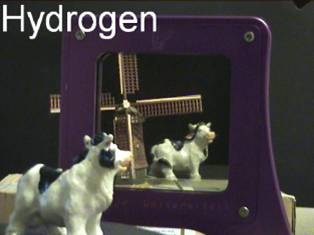 |
|
A
double glazing unit of which one of the glasses is coated with a thin
film mirror, based on a Magnesium-Gadolinium alloy. The coating is
inside the double glazing unit. |
|
The same Magnesium-Gadolinium
mirror but
now some hydrogen gas is applied inside the double glazing unit. The
windmill behind the mirror becomes visible. |
Since the discovery of the switchable mirror effect there is an
increasing interest in the fundamental understanding of this
switching effect and a search for applications which make use of it.
Potential applications are: hydrogen
detectors, privacy windows and optical switches for
preventing
overheating in solar applications. The last named application inspired
prof. Griessen to search for a different method of creating an optical
switch; hydrogen and heat are usually not good companions and in solar
applications the costs matter.
After a small "Friday afternoon" discussion and a few table-top
experiments we found that it is possible to make an optical switch just
with a well designed window surface and plain water as a switching
medium.
|

|
|
VU
University developed a low-cost optical
switch. The switch consists of a panel which is transparent when filled
with water and light reflecting when empty.
|
Critical
angle and total
internal reflection:
The optical switching
effect is
created by a physical effect called "total internal reflection":
Light
which
travels through a medium such as polycarbonate (PC) at incidence angles
larger than the so-called “critical angle (θc)”
cannot
escape
from the medium. This effect is called “Total internal
reflection”. The critical angle can be derived from the ratio
of
the index of refraction of the medium (n1) and
the
surrounding (n2) by Snells equation.
θc =
arc sin (n2 /
n1)
[n2 / n1 < 1]
Polycarbonate
has an index
of refraction (n) of 1.59. When it is placed in an environment of air
(n=1) the critical angle θc =
39°.
When air is replaced
by water
(n=1.33) the critical angle rises to
θc = 57°.
|
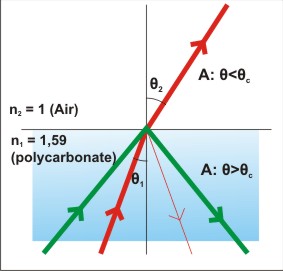 |
|
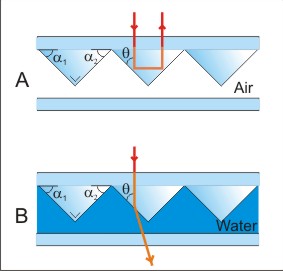
|
|
For
angles θ1 smaller than the
critical angle light
can escape from the medium (red line). For angles larger than
θc light
can not escape, "total internal reflection" occurs. |
|
Light
falls on an PC-air interface at 45° (A), which is larger than
θc and will be reflected (twice). When
air is replaced
by water (B) the incidence angle is smaller than θc
and light passes through. |
The optical switch
consists of a
double glazed unit of which one plate contains prismatic structures
with angles of 90°. Light which falls
orthogonal on the
surface (normal incidence) enters the prisms and is "total reflected"
at the prism-to-air interface since the incidence
angle θ
(45°) is larger then the critical angle θc
(39°). A second prism interface re-directs the light back, out
of
the structure. The structure is now in the reflecting state. When air
is replaced by water the critical angle changes to 57°. This
means
that light can now pass the prism-to-water interface. The optical
switch is now in the transmitting state.
Solar applications: Diurnal
and
seasonal changes
The light reflecting
state of the
optical switch depends on the
incidence angle of light. Since the prism-to-air interface is
45°
tilted with respect to the surface and θc =
39° there is
a band of + 6° and -6° around normal incidence where
total
internal reflection occurs and almost all light will return. For larger
or smaller angles some light will pass the prisms, an increasing angle
means more transmission of light, although light which escapes from a
prism might still be reflected back by a neighbouring prism.
Light
wich
escapes the prisms is slightly changed in direction. Therefore a second
layer of prisms can be used to enhance the light reflection over a
larger amount of angles.
When the optical
switch is used
in solar applications it is needed to know that the incidence
angle
of sun light is not only changing during the day but that
there is
also an incidence angle shift depending on the seasons. Depending on
the application it is possible to find an optimal shape of the
prismatic structure and a proper defined orientation of multiple
prismatic structured layers. In some applications it is needed to block
sunlight efficiently around noon, when the sun is most powerful, while
other applications ask for a good light reduction which is
constant during seasonal changes.
|
|
|
|
|
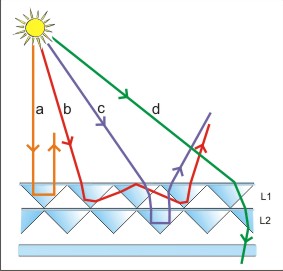 |
|
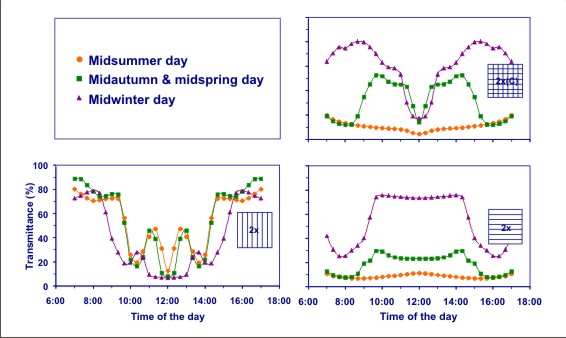
|
|
The
effect of light reflection is
optimal for light rays at or near normal incidence (a, b). However, in
a double prismatic layer light is efficiently reflected for a wide
interval of incidence angles. |
|
Optimal
configurations can easily be
designed for various applications. Some prism configurations are
efficient light blockers around noon, all year long. Other prism
configurations are better in blocking light during a larger part of the
day. |
Applications:
An obvious application
of an
optical switch would be in windows for houses and office
buildings. The amount of sunlight entering the building can be
selected by filling the double glazed unit with water. Reducing the
amount of sunlight will reduce the temperature inside the building on
sunny days. For these kind of applications it is important to know that
light slightly changes its direction while passing the unit in the
transmission state. Therefore the image will be distorted when you look
trough the window. This makes the window interesting to use as privacy
window. In reflection mode it avoids light to enter
the
building while in transmission mode light can enter the building, but
without a clear view.
|
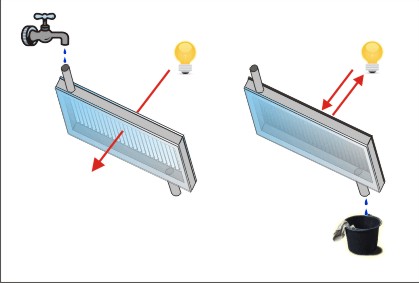 |
|
The
SolSwitch can be
used as a privacy window which can be switched to a light blocking
state. |
An other application
of the
SolSwitch is overheating protection. The optical switch can be
integrated in thermal solar collectors to prevent them from overheating
when no thermal energy is drained from the collector on sunny days.
Currently solar collectors are made from expensive materials like
aluminium and copper because these materials can withstand the high
stagnation temperatures (above 200 °C !!) inside the collector.
The
cost of a thermal solar collector could drop with a factor 10 when the
collector is based on a full plastic design. In order to allow a
plastic design it is needed to limit the temperature of the collector
below the degradation temperature of the used polymer (60 °C - 120 °C).
The temperature inside the collector is limited according the "fail
save" principle when the optical switch is integrated in the top plate
of the collector. When water is evaporated or drained from the
collector the optical switch is filled with air, which brings
the
switch in the reflecting state. With a proper alignment
towards
the sun the collector will reflect all light (when needed) around noon,
when the sun is most powerful. The maximum temperature inside the
collector is the evaporation temperature of the fluid inside
the
collector. In case of water the temperature is limited to 100
°C, but when an alcohol based
fluid is
used the temperature is even limited at a lower value. Alcohol
based fluids also prevent the solar collector from freezing in winter.
The collected solar power is extract from the switching fluid
and
fluid channels inside the (plastic) solar absorber plate via a
heat exchanger and stored in an insulated tank until needed.
|
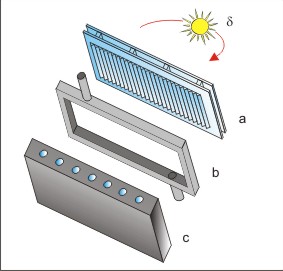 |
|
SolSwitch
can be used in low-cost all-polymer solar collectors to
prevent stagnation due to overheating. a) Thermally isolated prismatic
structure. b) Switching fluid reservoir. c) Plastic solar absorber with
(optional) thermal fluid channels. |
The SolSwitch can also
be used
in roofs of greenhouses. There are many advantages of
switching
the greenhouse roof from transparent to reflective:
- The plants in the greenhouse can be protected from "burn
damage"
on sunny days. Currently greenhouses are covered with a calc layer to
protect the plants during summer from excessive sunlight. Applying the
calc layer is time consuming, expensive, bad for the environment and is
not flexible. Once the calc is applied it's also blocking light at less
sunny days. When the optical switch is used to protect the plants it
can be used on-demand and this will result in effectively more
(hours) sunlight in the greenhouse and more production.
- The temperature inside the greenhouse can be regulated by
switching a certain amount of roof sections in the reflecting state.
Also the switching fluid inside the roof can be circulated to extract
heat from the greenhouse. These cooling methods allow that the (roof)
windows remain closed and that the climate (humidity and
raised CO2
levels) remain optimal and constant.
- The switching fluid inside the greenhouse will heat-up
during the
day. This heat can be harvested by a heat exchanger and be distributed
among households in the environment of the greenhouse or it can be
stored underground for re-use during winter.
- The Switching fluid in the greenhouse roof can be used as
a
filter for a certain part of the sunlight spectrum. Water allows
so-called "PAR" light (Photosynthetical Active Radiation, the light
that plants use to grow) to pass while "NIR" (Near Infra Red) light is
absorbed. The amount of NIR light to absorb can be tuned by solving
micro-particles of Copper Sulphate or clay in the switching fluid. In
that way an optimum in growth conditions can be selected.
- Some greenhouse products, like flowers, are grown by
using
artificial light during the night. This artificial light causes
so-called "light pollution" in the environment of the greenhouse. The
law demands the amount of light pollution to be minimised for
environmental reasons. When a greenhouse roof consists of a well
designed optical switch the greenhouse roof becomes reflective
during the night, which keeps the artificial light inside the
greenhouse. As a side effect there are less number of light units or
less powerful light units needed since the roof acts as an efficient
mirror.
|
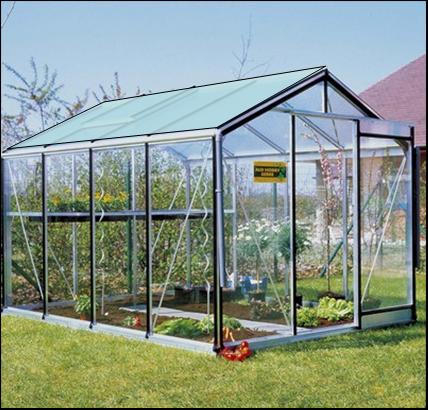
|
|
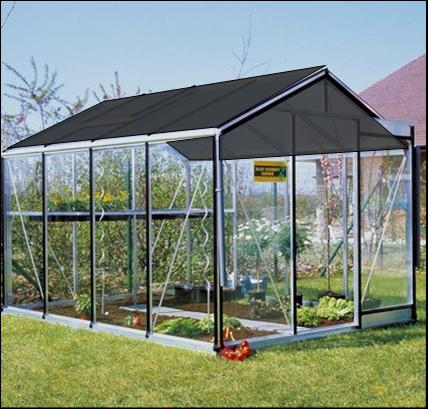
|
|
The roof of the
greenhouse is transparent
when the optical switch is filled with water
|
|
Sunlight is reflected on
the greenhouse
roof when water is drained from the optical switch
|












